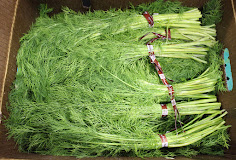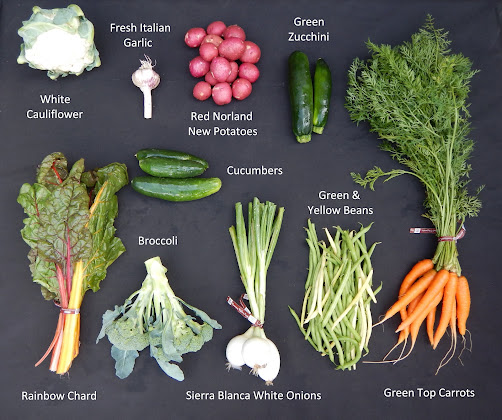What's In The Box
Italian Garlic: For a delicious treat, gently heat a bit of olive oil in a pan and add a few crushed cloves of garlic. Remove from heat and allow the flavor of the garlic to infuse into the oil for 10 minutes or so. Steam or boil new potatoes. While still hot, smash them with a fork and drizzle the garlic oil over them. Season with salt and pepper and enjoy!
Sierra Blanca or Talon Yellow Onions: We are finishing the last of the fresh white onions and starting on the first of our yellow storage onions. This week’s variety is “Talon,” and we ask that you forgive their appearance which may be a little rough. These onions are still very fresh from the field and have yet to form a fully dry skin that can be cleaned. Store them at room temperature where they’ll continue to dry down, if they last that long!
Broccoli or Cauliflower: We are almost finished with these crops until fall. Check out this week’s Cooking With the Box suggestions for a few new recipe ideas!
Zucchini and/or Scallopini Squash: With the summer heat we’ve been having, the zucchini fields have been doing their happy dance! Zucchini pairs well with all of this week’s summer vegetables. Add it to a simple pan of sauteed vegetables, include it in your morning scramble, slice it and throw it on the grill, shred it and add it to meatloaf, or layer it into lasagna….just a few ideas to get you started!
Orange Carrots: If you haven’t roasted any carrots recently, give them a try this week. Roasting brings out the natural sweetness in these carrots and they taste like candy!
New Potatoes: This week’s potato variety is “Red Prairie,” a red-skinned, white flesh potato. Handle with care as the skin is very delicate in their fresh state.
Italian Frying Pepper: This long, skinny pepper with a pointy end is known for being a very flavorful pepper, both when it is green as well as when it turns red. Cooking brings out the flavor, so consider using this pepper to make kabobs, grill it, or sauté with onions. This pepper is classified as a sweet pepper and does not have any heat.
Red Amaranth: This gorgeous summer green is known for its ability to thrive in the heat of the summer, and it’s loaded with nutrients. Compared to spinach, amaranth leaves have three times more vitamin C, calcium, and niacin! In this more mature state, amaranth is best used as a cooking green. Remove the leaves and tender portions of the stem. It may be cooked in any way you might cook spinach and it pairs well with other summer vegetables including peppers, potatoes, zucchini, sweet corn, and onions!
Jalapeño Pepper: There is one jalapeño pepper in your box, so make sure you locate it! If you are not a fan of hot peppers, feel free to deposit your pepper in the swap box and share it with another member. Of course, you can always adjust the amount of heat from the pepper simply by using only the amount that is to your liking and/or by removing the white ribs and seeds which is where most of the heat is.
Green Beans: If you have more food than you can eat this week, consider preserving your green beans for use over the winter months. You can do this by blanching them first, then freezing them in bags. Alternatively, you can turn them into pickled dilly beans!
Thai Basil: Thai basil has a unique flavor that is a bit like mint with a touch of licorice. It’s actually a great herb to pair with eggplant, especially in curries!
Sweet Corn: As this is our official first week of sweet corn season, it’s time for our annual public service announcement: KEEP YOUR CORN COLD! The key to truly sweet corn is to keep it in the refrigerator to preserve its natural sugars. Heat, as well as extended storage, are the two factors that allow the sugars to turn to starch and diminish its sweetness. If storage space is an issue, remove the husks first and/or eat it within a day or two of receiving it!
Recipe Suggestions & Inspiration For This Week’s Box Contents
Grilled Eggplant “Caviar” (See Featured Recipe)
Grilled Eggplant Salad with Quinoa & Dates
Roasted Eggplant with Spiced Chickpeas and Tomatoes
Eggplant & Chickpea Patties
Chocolate Eggplant Torte
Easy Baba Ghanoush (Eggplant Dip)
Better Thank Takeout Sweet Thai Basil Chicken
Thai Basil Lemonade
Mint & Thai Basil Gelato
Roasted Maple Curry Carrots
Honey Garlic Ginger Roasted Carrots
Mediterranean Cauliflower Casserole
Vegan Broccoli Miso Soup
Vegan Carrot Pesto Pasta
Cheesy Broccoli Scrambled Eggs
Black Beans with Amaranth
Red Lentil Soup with Amaranth
Summer Rice & Cheese Gratin with Zucchini & Amaranth Greens
Amaranth & Corn Stewed in Coconut Milk
Sweet Corn Salsa
Sweet Corn Salad with Green Beans & Hazelnuts
Summer Corn with Green Beans and Herb Butter
Dilly Beans
Saltimbocca of Zucchini
Kung Pao Zucchini
Zucchini Blueberry Muffins
Cheesy Vegetarian Zucchini Enchiladas
New Potatoes in Garlic Cream Sauce
Crushed New Potatoes with Garlic & Herbs
Vegetable Feature: Eggplant
Grilled Eggplant "Caviar"
 |
| Photo from Olia Hercules' book, Mamushka: A Cookbook, Recipes from Ukraine & Eastern Europe |
- Place the tomatoes, green peppers, and eggplant on a hot barbecue or oil lightly and place under a hot broiler. Cook them, turning occasionally, until the vegetables are well charred and have pretty much collapsed.
- Pop the vegetables into a large bowl, cover with plastic wrap, and leave them to sweat for 10 minutes—it will then be easier to take the skins off.
- Core and deseed the peppers, discarding the stems. Take off most of the tomato and eggplant skins; if some black bits remain, don’t worry, as they will add a beautiful smoky flavor. Roughly chop all the grilled vegetables.
- Mix the chopped vegetables with the garlic and onion, then dress with a slither of oil. Season well with salt and pepper, then stir through the herbs. Serve with some crusty bread.




.JPG)

.jpg)







.jpg)